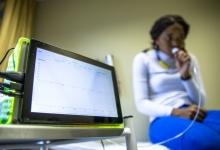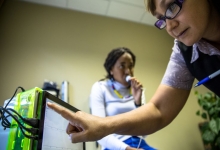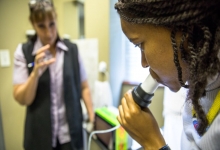Nanomaterials for sensing applications
Over the years, the CSIR’s nanomaterials for sensing applications group has developed significant competencies in designing and engineering novel nano-enabled materials, followed by their fabrication and testing, as well as the development of electronic device prototypes. The group continues to direct its research and development endeavours to the improvement of sensor performance for medical, air quality monitoring and food safety applications.
Research platforms
Research platforms include nano-scale featured materials design and engineering, and the development of electronic device prototype for human breath analysis, indoor and outdoor air quality monitoring and food safety applications.
Nanosensors for human breath analysis
Platform background and focus
This platform focuses on the development of nanosensors, and the design and production of electronic device prototypes for medical application. The team’s vision is based on the basic principle that every human illness expresses biomarkers into the bloodstream and, hence, into the endocrine and other systems. Invasive devices require blood-based biomarkers or actual biopsy of the affected regions. The CSIR focuses on non-invasive disease detection. For non-invasive detection of illness, biomarkers are sought in sweat, tears, saliva and breath. For non-disposable parts, breath is the best medium in which to detect illness non-invasively. Thus, the team has concentrated on breath analysis using gas sensors based on various types of nano-materials.
Gas nanosensors for indoor and outdoor air quality monitoring
Platform background and focus
Air pollution can cause health problems like diabetes and high blood pressure, which are identified as the pre-existing medical conditions that raise the chances of fatality from Covid-19 infection. This platform focuses on the development of highly stable, sensitive, and specific gas sensors based on nanostructured materials for the monitoring of carbon monoxide, methane and nitrogen dioxide gases for environmental safety and security purposes. The continuing interest in this area is driven by the increased emission of toxic gases in industrial processes that result in a detrimental threat to public health and environmental sustainability. CSIR researchers, therefore, have focused their efforts on developing the know-how on the fabrication of metal oxides at a nanoscale to manipulate them as per user specifications, co-develop gas sensors with local manufacturers for the local, regional and global markets, and fabricate the nanosensor prototype that is traceable to national measurement standards for the gas industry.
Gas nanosensors for food safety
Platform background and focus
This platform focuses on the monitoring and control of food quality status using nano-materials-based sensors tailored to detect toxic gases such as acetone, ethylene, ammonia and carbon dioxide released from contaminated food products at pulse per million to pulse per billion levels, while, at the same time, discriminating one specific gas among the other gases at specific atmospheric conditions. The interest in this project is driven by an increasing concern over food poisoning, which is one of the major problems in the food industry worldwide that is negatively impacting consumers’ health and safety, as well as the economy. This has led to extensive exploration of technologies that can recognise toxic gases at an early stage to provide solution to the food poisoning problem.
Nanomaterials engineering and design
The nanomaterials for sensing applications group has expertise in nanomaterials synthesis and design, making use of both the bottom-up and top-down approaches, followed by optimisation through the modification of their surface through metal nanoparticles addition and doping, as well as their characterisation. The CSIR produces active nanosensor layers based on nanostructured hybrid and functionalised metal oxides as a receptor with superior electrical and conductive properties for targeted application in gas sensors.
Gas sensor measurements and testing
The CSIR fabricates nanostructured materials to produce active sensing layers, followed by their measurements and testing for specific gases at desired specific atmospheric conditions as per end-user specifications.
Infrastructure:
- Sensing station;
- Micro manipulator system;
- Electron-beam lithography attachment using Scanning Electronic Microscope (SEM) for characterisation; and
- Physical vapour deposition technique.






